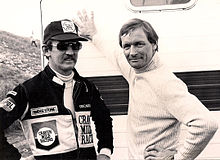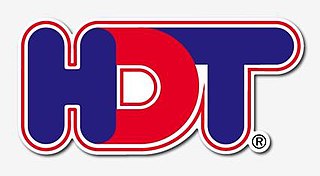
The Holden Dealer Team (HDT) was Holden's semi-official racing team from 1969 until 1986, primarily contesting Australian Touring Car events but also rallying, rallycross and Sports Sedan races during the 1970s. From 1980 the Holden Dealer Team, by then under the ownership of Peter Brock, diversified into producing modified road-going Commodores and other Holden cars for selected dealers via HDT Special Vehicles.
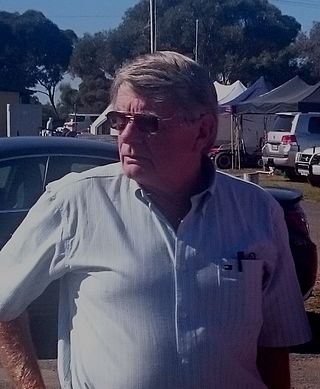
Colin John Bond is an Australian former racing driver. Bond reached the highest levels in Australian motorsport in 1969 when he was recruited by Harry Firth to the newly formed Holden Dealer Team. He quickly found success, winning the 1969 Hardie-Ferodo 500 mile race at Bathurst, New South Wales in a Holden Monaro.

Kevin Bartlett, often known by his nickname "KB", is an Australian former open wheel and touring car racing driver who won the Australian Drivers' Championship in 1968 and 1969, as well as the prestigious Bathurst 1000 in 1974. Bartlett was named in Wheels magazine's annual yearbook in 2004 as one of Australia's 50 greatest race drivers. He placed #15 on the list.

Allan Maxwell Grice, known to motor-racing fans as "Gricey", is an Australian former racing driver and politician, most famous for twice winning the prestigious Bathurst 1000, and as a privateer driver of a Holden in the Australian Touring Car Championship.
Henry Leslie Firth was an Australian racing driver and team manager. Firth was a leading race and rally driver during the 1950s and 1960s and continued as an influential team manager with first the Ford works team and then the famed Holden Dealer Team (HDT) well into the 1970s. Firth’s nickname was "the fox", implying his use of cunning ploys as a team manager.
The 1979 Hang Ten 400 was an endurance motor race held at the Sandown Park circuit in Victoria, Australia on 9 September 1979. It was staged over 129 laps of the 3.11 km circuit, a total of 401 km. The race was Round 1 of the 1979 Australian Championship of Makes and as such it was open to Group C Touring Cars. It was the fourteenth in a sequence of annual Sandown long distance races. The race was won by Peter Brock.

The Australian GT Championship is a CAMS-sanctioned national title for drivers of GT cars, held annually from 1960 to 1963, from 1982 to 1985 and from 2005. Each championship up to and including the 1963 title was contested over a single race and those after that year over a series of races. The categories which have contested the championship have not always been well defined and often have become a home for cars orphaned by category collapse or a sudden change in regulation.
John Francis Harvey was an Australian racing driver. He was a top Speedcar driver for many years in the 1950s and 1960s, winning many championship races including the NSW Championship for three successive years and the Victorian Championship twice before turning his skills to road racing where he had a long and successful career until his retirement at the end of 1988. In 1987 John made history driving the General Motors Sunraycer to victory in the inaugural World Solar Challenge from Darwin to Adelaide, the first international race for purely solar powered cars.
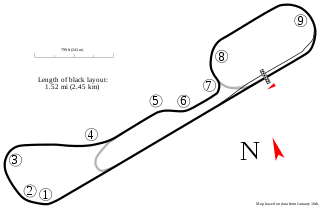
The Adelaide International Raceway is a permanent circuit owned by Australian Motorsport Club Limited under the auspices of the Bob Jane Corporation. The circuit is located 26 km (16 mi) north of Adelaide in South Australia on Port Wakefield Road at Virginia, and is adjacent to Adelaide's premier car racing Dirt track racing venue, Speedway City. AIR is owned by the Bob Jane Corporation and run by the Australian Motorsport Club Ltd.
The 1989 Australian Drivers' Championship was an Australian motor racing competition open to racing cars complying with CAMS Formula Holden regulations. The championship winner was awarded the 1989 CAMS Gold Star as the Australian Drivers' Champion. It was the 33rd running of the Australian Drivers' Championship and the first to feature the Formula Holden class which had been developed during 1988, originally named Formula Australia.
The Sun-7 Chesterfield Series was an Australian touring car racing series staged at Amaroo Park in Sydney, New South Wales from 1971 to 1981. The actual series name varied from year to year, according to the commercial sponsorship secured by the series promoters, the Australian Racing Drivers Club.
The 1979 Australian Touring Car Championship was a CAMS sanctioned Australian motor racing title open to Group C Touring Cars. It began at Symmons Plains and ended at Adelaide International Raceway after eight rounds. The title, which was the 20th Australian Touring Car Championship, was won by Bob Morris driving a Holden Torana.
The 1978 Australian Touring Car Championship was a CAMS sanctioned Australian motor racing title open to Group C Touring Cars. The title, which was the 19th Australian Touring Car Championship, was won by Peter Brock. It was his second Australian Touring Car Championship victory.
The 1975 Australian Touring Car Championship was a CAMS sanctioned Australian motor racing title open to Group C Touring Cars. The championship began at Symmons Plains and ended at Lakeside after seven rounds. It was the 16th Australian Touring Car Championship.
The 1974 Australian Touring Car Championship was an Australian motor racing competition open to Group C Touring Cars. Authorised by the Confederation of Australian Motor Sport as an Australian National Title, it was the 15th running of the Australian Touring Car Championship. The championship began at Symmons Plains on 4 March 1974 and ended at Adelaide International Raceway on 9 June after eight rounds.
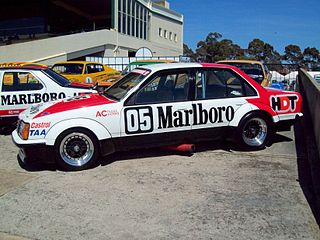
The 1980 Australian Touring Car Championship was an Australian motor racing competition for Group C Touring Cars. Authorised by the Confederation of Australian Motor Sport as a National Title, it was the 21st Australian Touring Car Championship.
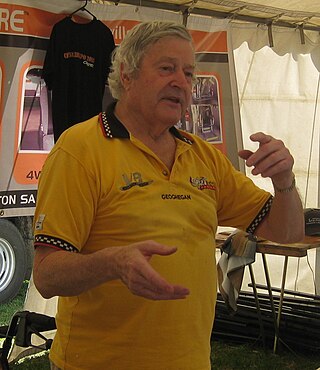
Leo Geoghegan was an Australian former racing driver. He was the elder of two sons of former New South Wales car dealer Tom Geoghegan, both of whom become dominant names in Australian motor racing in the 1960s. While his younger brother Ian "Pete" Geoghegan had much of his success in touring car racing, winning five Australian Touring Car Championships, Leo spent most of his racing career in open wheel racing cars.

Johnnie Walker was an Australian racing driver.

Birrana was the name of two motor racing organisations, both associated with South Australian racing driver and engineer Malcolm Ramsay. From 1971 to 1978 Birrana constructed a series of successful open-wheel racing cars under the Birrana name. It also constructed a Holden Kingswood HQ for Ramsay to compete in Group C Improved Production Touring Cars racing.
AMSCAR was a touring car series held in Australia between 1979 and 1997, based at Amaroo Park in Sydney.

